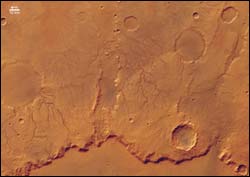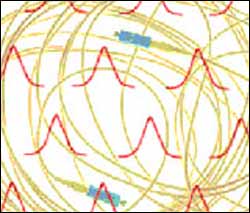Physics and Astronomy
This area deals with the fundamental laws and building blocks of nature and how they interact, the properties and the behavior of matter, and research into space and time and their structures.
innovations-report provides in-depth reports and articles on subjects such as astrophysics, laser technologies, nuclear, quantum, particle and solid-state physics, nanotechnologies, planetary research and findings (Mars, Venus) and developments related to the Hubble Telescope.

Rim of Crater Huygens on Mars
These images, taken by the High Resolution Stereo Camera (HRSC) on board ESA’s Mars Express spacecraft, show the eastern rim of the Martian impact crater Huygens.
The images were taken during orbit 532 in June 2004 with a ground resolution of approximately 70 metres per pixel. The displayed region is centred around longitude 61° East and latitude 14° South.
Huygens is an impact structure, about 450 kilometres wide, located in the heavily cratered southern highlands of

Built via the internet, student satellite coming to life at ESA-ESTEC
Scattered in universities across Europe, a 250-strong team of students have never collectively met in person, but between them they have built a space-ready satellite. SSETI Express is currently being integrated in an ESA cleanroom for a planned launch in May next year.
Collaboration between the pan-European network of students, universities and experts involved in the Student Space Education and Technology Initiative (SSETI) has been carried out via the internet. Now that the co

OECD develops policy recommendations for a new generation of large projects in astronomy
Intergovernmental organisation urges scientists to present a unified coherent vision for large, expensive projects
The OECD Global Science Forum has developed findings and recommendations regarding future large projects in astronomy. Some of the recommendations are directed towards the international scientific community, others pertain more to the work of government funding agencies. Among the conclusions are: the need for a globally-coordinated scientific vision of the most imp

Super slow light may help speed optical communications
Light is so fast that it takes less than 2 seconds to travel from the Earth to the moon. This blazing fast speed is what makes the Internet and other complex communications systems possible. But sometimes light needs to be slowed down so that signals can be routed in the right direction and order, converted from one form to another or synchronized properly.
Now, physicists at the National Institute of Standards and Technology (NIST) have proposed a new way to slow light down to

Scientists prepare for space probe’s plunge into Titan’s atmosphere
On Jan. 14, 2005, the Huygens probe will plow into the orange atmosphere of Saturn’s moon, Titan, becoming the first spacecraft to attempt to land on a moon in our solar system since the Soviet Union’s Luna 24 touched down on Earth’s moon in 1976.
Though scientists hope that Huygens will survive the plunge, it will be flying blind through hydrocarbon haze and methane clouds to a surface that could consist of seven-kilometer-high ice mountains and liquid methan

The Liverpool Telescope catches first gamma ray burst
On Wednesday 6 October 2004 a team of UK astronomers from Liverpool John Moores University and the University of Hertfordshire used the world’s largest robotic optical telescope, the Liverpool Telescope, to detect the optical light, or afterglow, from a Gamma Ray Burst (GRB).
“Gamma ray bursts are the most energetic explosions in the Universe and it is very exciting to have detected a Gamma Ray Burst afterglow for the first time with the Liverpool Telescope and then to watch i